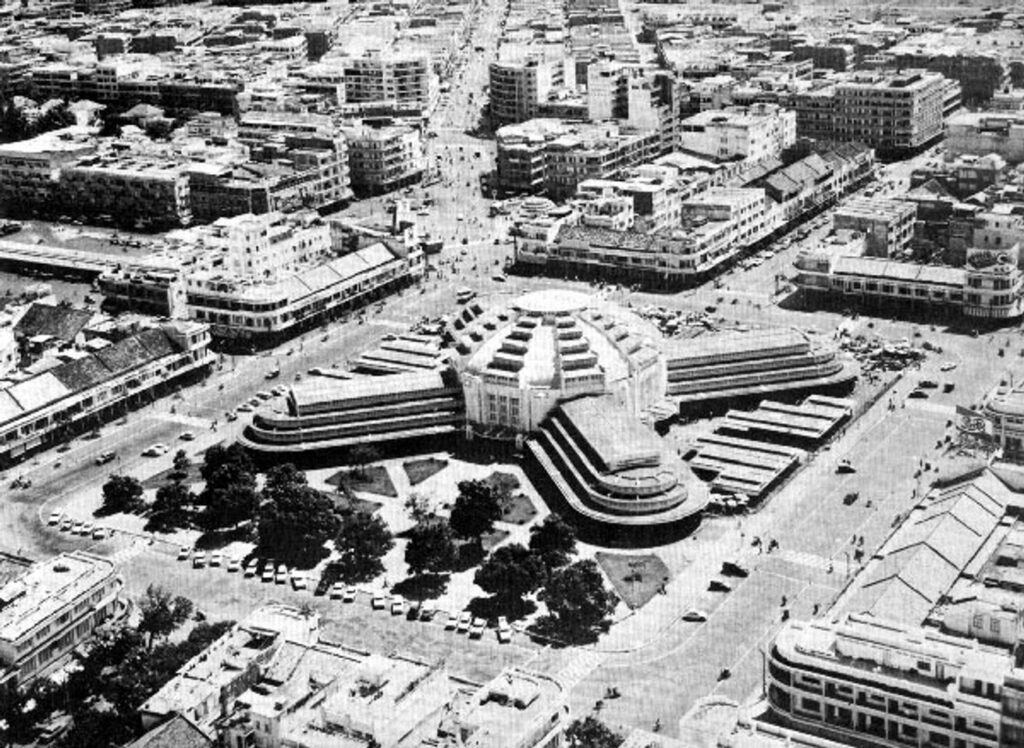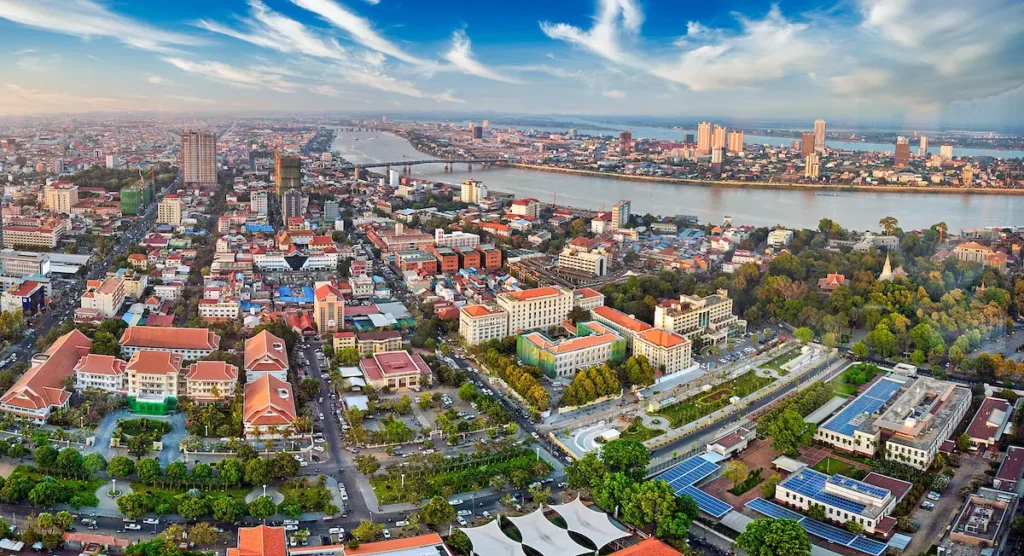Phnom Penh Then and Now
Phnom Penh Then
Phnom Penh, the capital of Cambodia, derives its name from the iconic Wat Phnom, a small hill where a legend is tied to the city’s origins.
According to the legend, in 1372, a wealthy widow named Penh discovered a Koki tree floating down the Tonlé Sap River after a storm. Inside the tree were four bronze Buddha statues and a stone statue of Vishnu.
Penh instructed the villagers to raise the hill near her house and build a temple using the tree’s wood, placing the statues inside.
This temple, known as Wat Phnom Daun Penh, became a symbol of the city’s spiritual and cultural heritage.
Phnom Penh’s former official name, Krong Chaktomuk Serei Mongkol, reflects the grandeur and significance attributed to the city.

The full name, given by King Ponhea Yat, translates to “the place of four rivers that gives the happiness and success of the Khmer Kingdom, the highest leader, as well as the impregnable city of the God Indra of the great kingdom.”
The name highlights the city’s strategic position at the confluence of four rivers and its important role in the Khmer Empire.
Today, Phnom Penh stands as the heart of Cambodia, blending its rich history with modern development.
Related Article: Kathmandu Then and Now
Phnom Penh History
Phnom Penh, the capital city of Cambodia, has a rich and dynamic history that reflects the rise, fall, and resurgence of the Khmer Empire.
Founded in 1434, it was established to replace Angkor Thom as the capital of the Khmer nation. Initially, Phnom Penh flourished as a vibrant center of political and cultural activity.
However, the city was abandoned several times due to internal conflicts and external threats.
It wasn’t until 1865, under the reign of King Norodom, that Phnom Penh was re-established as the capital, marking a new era in its development.
Related Article: Colombo Then and Now
During the 20th century, Phnom Penh became a bustling urban center, thriving economically and culturally.
It was a hub for various industries, including textiles, pharmaceuticals, and rice milling, though its true wealth was in its cultural heritage.
The city was home to numerous educational institutions, including the National University of Phnom Penh (founded in 1956), and several specialized institutions for agriculture, engineering, and the arts.
These institutions contributed significantly to the intellectual and cultural development of the country.
Related Article: Dhaka Then and Now

The city’s architectural landscape was defined by its proximity to the Royal Palace and Preah Morakot Pagoda, famous for its silver-tiled floor and treasures like the golden Buddha statue.
The Royal Palace complex, built in 1919, housed the Royal Palace Museum and the Veal Mien (Royal Plain), where national congresses were held.
Phnom Penh also boasted the National Museum, which preserved and displayed priceless Khmer art and historical documents and was renowned for its Royal Ballet, a highly cherished cultural tradition that depicted ancient Buddhist and Hindu myths through dance.
However, Phnom Penh’s prosperity was shattered when the Khmer Rouge came to power in 1975.
Related Article: Lahore Then and Now
The regime forcibly evacuated the city, sending its residents into the countryside in a brutal attempt to “reset” Cambodian society.
The city remained abandoned for several years until Vietnamese forces overthrew the Khmer Rouge in 1979, leading to Phnom Penh’s gradual repopulation.
The Khmer Rouge’s genocide, which targeted intellectuals and professionals, left the city’s educational system in ruins, requiring years of rebuilding.
Today, Phnom Penh is not only a cultural and educational center but also a vital port city for the Mekong River valley.
Related Article: Karachi Then and Now
Despite being situated 180 miles from the sea, its strategic location allows it to access the South China Sea through Vietnam, boosting trade in goods like dried fish, cotton, and pepper.
The city is connected by an extensive network of highways and rail lines, facilitating trade with other parts of Cambodia and neighboring countries.
With a growing population, Phnom Penh continues to evolve as Cambodia’s political, economic, and cultural heart.
Related Article: Istanbul Then and Now
Phnom Penh Now

Phnom Penh, the capital and most populous city of Cambodia holds a central place in the nation’s political, economic, and cultural life.
The city became the capital during the French protectorate in the 19th century, marking a pivotal moment in Cambodia’s modern history. Before Phnom Penh, the capital was Oudong, which had been the seat of the Khmer monarchy.
However, Phnom Penh succeeded Angkor Thom as the capital of the Khmer Empire, although it was abandoned multiple times due to internal conflicts and external pressures.
Related Article: Riyadh Then and Now
It was not until 1865, under King Norodom, that Phnom Penh was re-established as the capital, setting the stage for the city’s future growth and prominence.
Phnom Penh quickly developed into a significant economic and cultural hub, with industries such as textiles, pharmaceuticals, machine manufacturing, and rice milling contributing to its prosperity.
However, the city’s real strength lay in its cultural institutions, which became a defining feature of Phnom Penh’s identity.
Related Article: Abu Dhabi Then and Now
The Royal University of Phnom Penh, established in 1960, became a center of higher learning with a focus on engineering, fine arts, technology, and agricultural sciences.
The city also housed specialized institutions like the Royal University of Agronomic Sciences and the Agricultural School of Prek Leap, which played key roles in advancing the nation’s education and research sectors.
Phnom Penh earned the nickname “Pearl of Asia” in the early 20th century, thanks to its colonial French architecture, which blended European styles like Art Deco with traditional Cambodian design.
Related Article: Doha Then and Now
This architectural legacy added to the city’s appeal as both a cultural and historical destination.
Today, Phnom Penh, along with Siem Reap and Sihanoukville, is a major tourist destination in Cambodia, attracting both international and domestic visitors who come to experience its rich history, vibrant culture, and modern amenities.
Situated on the banks of the Tonlé Sap, Mekong, and Bassac Rivers, Phnom Penh is home to over 2 million people, roughly 14% of the country’s population.
Related Article: Ahmedabad Then and Now
The Greater Phnom Penh area includes the neighboring Ta Khmau city and parts of Kandal province, making it the largest metropolitan area in Cambodia.
The city has hosted a variety of regional and international events, such as the ASEAN Summits in 2002, 2012, and 2022, the 32nd Southeast Asian Games, and the 12th ASEAN Para Games, highlighting its role as a key player on the global stage.
Related Article: Hyderabad Then and Now
Looking ahead, Phnom Penh is set to host the 2029 Asian Youth Games, making it the first Cambodian city and the second Southeast Asian city to do so.
This milestone underscores the city’s continued growth and its emerging prominence in the region.
Related Article: Bengaluru Then and Now
FAQs
Phnom Penh is famous for being the capital and largest city of Cambodia. It is known for its rich cultural heritage, historic landmarks like the Royal Palace and Wat Phnom, and its tragic history, particularly during the Khmer Rouge regime.
The city also boasts French colonial architecture and serves as the nation’s economic and cultural center.
Phnom Penh is the richest city in Cambodia, serving as the country’s economic hub with the highest concentration of businesses, industries, and government institutions.
Phnom Penh is in Cambodia, located in Southeast Asia.
Yes, Phnom Penh is worth visiting for its historical and cultural attractions, including the Royal Palace, National Museum, and the Killing Fields, as well as its vibrant markets and riverside views.
It’s an important destination for those interested in Cambodian history and culture.






























